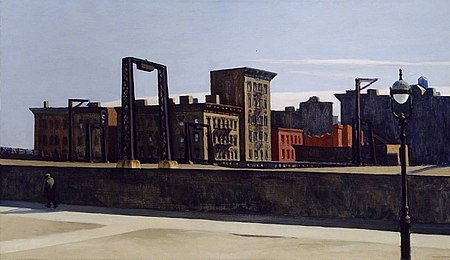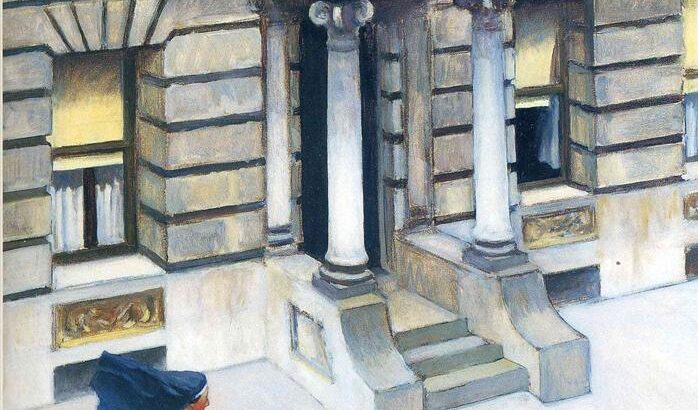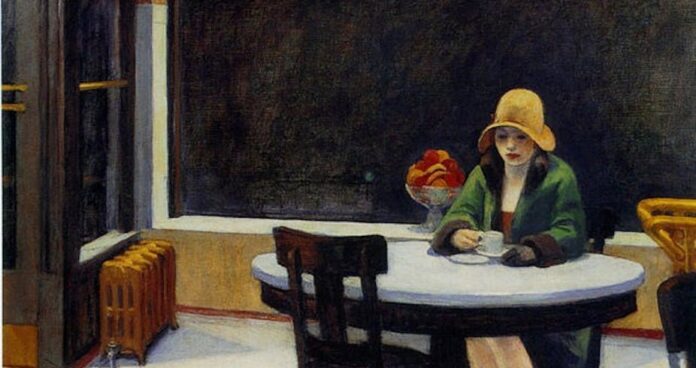By Katerina Taxiaropoulou,
From T-shirts to posters and mugs, the paintings of Edward Hopper have stood the test of time and rightfully made the artist one of the most renowned realist painters of 20th century America. As a quiet and introverted person as he was, Hopper spent a major part of his life observing the world around him and then transferring it all onto the canvas. A common theme among his works is that of isolation and alienation in the cityscape. In an interview, he confesses: “Unconsciously, probably, I was painting the loneliness of a large city” (The Artist’s Voice). Hopper’s paintings New York Pavements (1924) and Manhattan Bridge Loop (1928) best convey the subject of loneliness as part of modern experience.
Before attempting any detailed analysis of the paintings, however, it would be preferable to begin with an introduction of the painter himself, as well as to the socio-cultural context in which he produced his works. Edward Hopper was born in New York in 1882 and died, in the same place, in 1967. As he spent most of his years in the cityscape, he developed a great interest in urban life and its darker side. Thus, he chose to depict “the everyday realities of the world” as he viewed them (Edward Hopper-Bio).
Hopper painted in a transitional period for the United States. From the early twentieth to the mid-twentieth century, cities grew significantly and so did their populations, technology developed and in general urban life became “the center of a new experience” (Edward Hopper’s Urban Landscapes). In such a shifting reality, people moving from rural to urban spaces were mentally affected and so they would often isolate themselves from the world, a phenomenon from which many artists at the time took inspiration for their works. Indeed, by the 1920s Hopper had developed a mature style, depicting scenes of profound loneliness in the “cold and bleak” urban settings (Edward Hopper’s Urban Landscapes).
To represent this feeling of isolation as part of the modern experience, Hopper put great emphasis on the human figure in his paintings. Yet, what is distinct about his work is the absence of crowds. This exclusion is not a random one. As Robert Hobbs claims, that “which is absent is as important as what is present” (Edward Hopper). Hopper chooses to depict central places of a city, which under normal circumstances are heavily crowded, and devoid them of human presence. Instead, he places his focus on buildings and sharp architectural structures. Even when there is depiction of human presence, Hopper portrays it in such a way, so as to emphasize the concept of isolation and alienation.

In both New York Pavements and Manhattan Bridge Loop, the figures are “diminished and insignificant to the massive architectural environment” (Edward Hopper’s Urban Landscapes). They are solitary. In each of the paintings, there is only one human figure: in New York Pavements, a nun pushing a baby carriage, and in Manhattan Bridge Loop, a man walking with his back turned on the viewer. Also, these figures find themselves on one side, taking a very small space of the canvas in contrast with the intensely structured buildings. This contrast between the solitary figure which is “pushed to the side” and the imposing architecture of the environment underlines the theme of loneliness and isolation and generally “the bleakness typical of so many of Hopper’s portrayals of urban centers” (Edward Hopper’s Urban Landscapes).
Furthermore, one could not overlook the great role of the use of light in conveying that feeling of urban loneliness. For Hopper, light constitutes a major expressive force, even more so when there is a juxtaposition between natural and artificial lighting. On the one hand, natural light in Hopper’s works does not give any warmth to the scenes depicted, but rather, it creates a cold atmosphere. For example, in New York Pavements, cold lighting accentuates the paleness of the woman’s face, making at the same time the environment seem harsh and unfriendly. According to Gulan, “[n]atural light creates a distinctive atmosphere in Hopper’s paintings and it is associated with the feeling of alienation because of its cold and harsh qualities” (Edward Hopper’s Urban Landscapes). Both in New York Pavements and Manhattan Bridge Loop, natural light is cold and dim, as if fading away, an impression which is accurate, given that Hopper used to depict urban spaces at dusk. Natural light also helps “define the architectural structures of the city, highlighting their rigid and colossal qualities”, thus emphasizing the imposing power of the cityscape building.

On the other hand, Hopper employed artificial light, a change that “defined a new, modern experience in urban centers” (Edward Hopper’s Urban Landscapes) along with natural light to accentuate the isolation people living in a large city experience. In Manhattan Bridge Loop, there are electric lamps placed on the streets. They are not at the moment of illustration lighting the street, yet there is an implication that they are about to be. Note that the scene most probably takes place at dusk, with these lambs representing some kind of transition. According to Gulan, this transition “is not only a visual transition but also a symbolic one, as the day comes to an end, which could refer to the end of an era” (Edward Hopper’s Urban Landscapes). As mentioned above, this is a time in which people move from rural to urban places and because of this abrupt change, many of them become depressed and isolate themselves. Under this light, Gulan’s argument that “it is the artificial light that replaces the natural light, which refers to the alienation from nature, as a result of the transition from rural areas to urban centers”, stands historically accurate. There is something depressing about this transition, and the combined use of natural and artificial light plays a major role in portraying it.
All in all, it seems that Hopper’s paintings New York Pavements and Manhattan Bridge Loop portray the feeling of loneliness that characterized New York City during the decade of the 1920s. The unequal representation of the marginalized human figure in contrast with the imposing standing of urban architecture as well as the combination of natural and artificial light are both elements used to highlight the common theme of isolation as part of modern experience, that is, urban life.
References
- Edward Hopper-Bio. nga.gov. Available here
- Edward Hopper’s Urban Landscapes: Modern Experience and Alienation. aura.american.edu. Available here
- Edward Hopper. Archive.org. Available here
- The Artist’s Voice: Talks with Seventeen Artists. Archive.org. Available here




